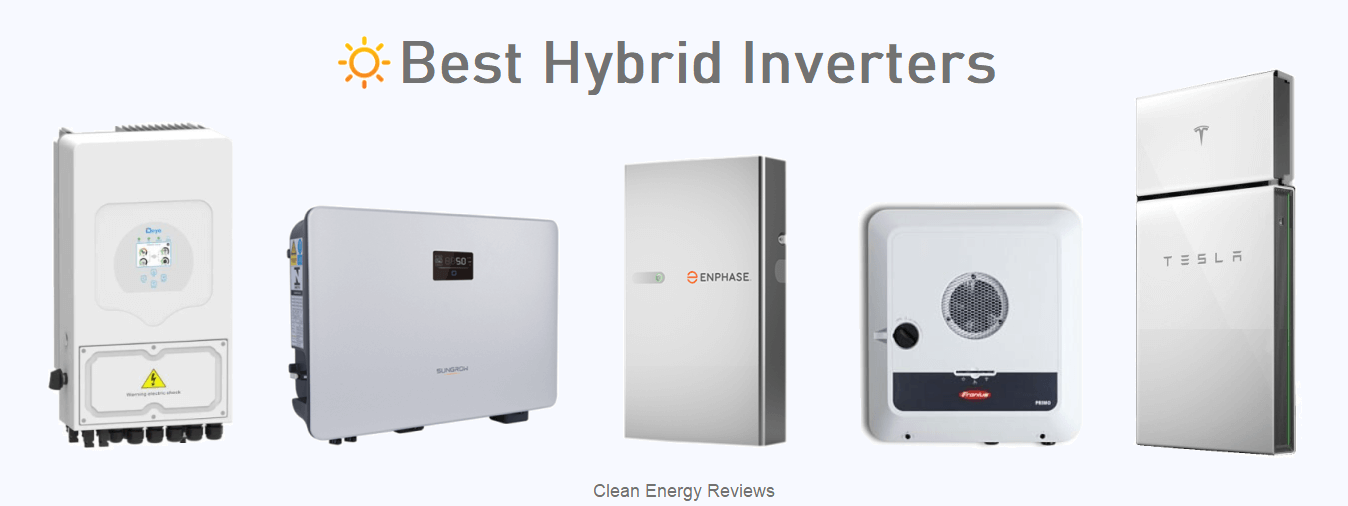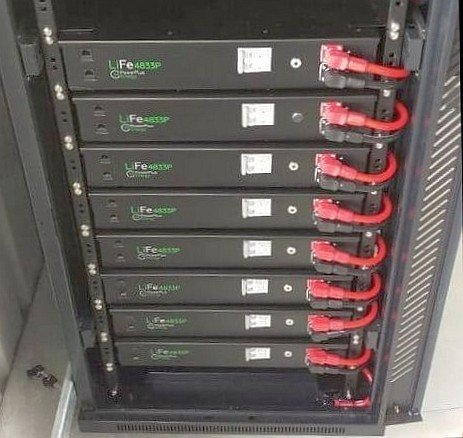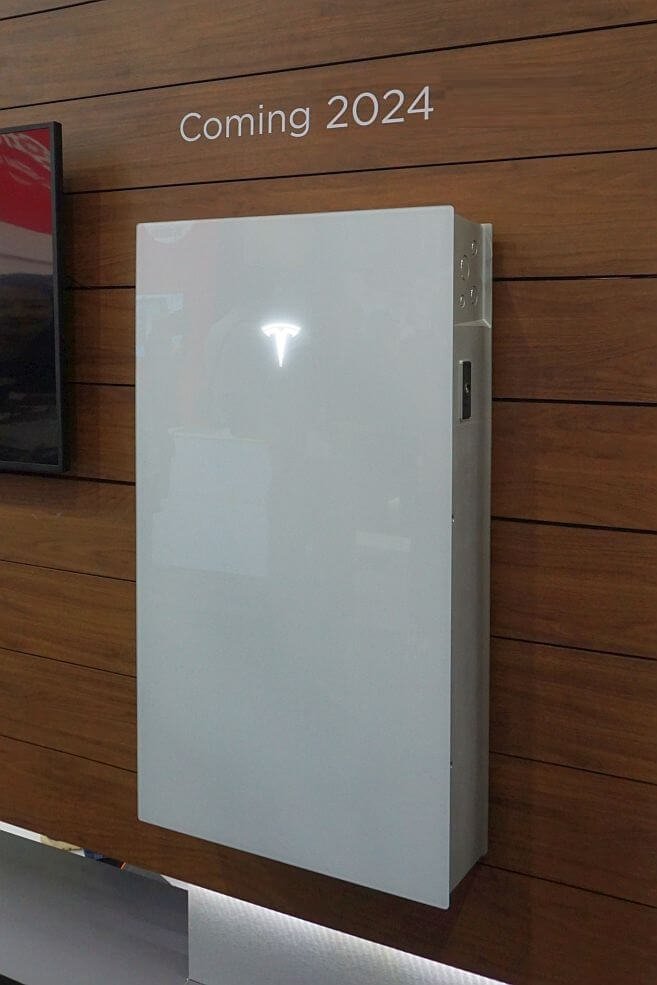Lead-acid Vs lithium-ion batteries
Over recent years, lithium-ion batteries have surged in popularity and overtaken lead-acid batteries as the preferred option for home solar storage systems. But this does not mean the lead-acid battery is dead. Lead-acid battery technology is still advancing, with the release of high-performance sealed tubular Gel batteries from companies such as BAE and Sonnenschein and advanced lead-carbon batteries from Narada, GS Yuasa and YHI Power.
In this review, we compare two popular lithium-ion (LFP) batteries from leading manufacturers, Simpliphi and Pylontech, against advanced deep-cycle lead-acid and lead-carbon batteries. A direct comparison is not easy as each battery type behaves differently depending on the rate of discharge, depth of discharge, and cycle life required. The full battery comparison criteria are explained in the detailed solar battery review.
Note, This review does not include unsealed or flooded lead-acid batteries as they require high levels of maintenance, specially ventilated area’s, and any cost savings can be outweighed by regular maintenance work required throughout the life of the battery.
Best batteries for solar storage
Lithium-ion batteries are now widely regarded as the best battery type for general energy storage applications due to their high energy density and very high efficiency. However, there is more than one type of lithium battery available. Most lithium batteries for home energy storage generally use lithium iron phosphate (LiFePO4 or LFP) cells due to the lower cost and long cycle life. However, several well-known manufacturers, such as Tesla and LG Chem, use Lithium NMC cells. For this review, we focus on Lithium LFP batteries from leading US manufacturer Simpliphi and the popular Chinese manufacturer Pylontech.
Battery Efficiency
Battery efficiency, or round trip efficiency, is the charging and discharging efficiency or loss during use. Due to the laws of physics, the transfer of energy from one form to another results in energy loss. In this case, the transfer is from electrical to chemical energy during battery charging and chemical back to electrical during discharge. Generally, losses from lead-acid batteries are much higher at 15-20%, while most lithium-ion batteries are significantly lower at 2-8%.
Deep-cycle lead-acid efficiency = 76% - 85%
Lithium LFP battery efficiency = 92% - 98%
Another problem with lead-acid or lead-carbon battery systems is the longer charge time compared to lithium systems. A lead-acid charge cycle (bulk-absorption stages) can take 2 to 4 hours, depending on the depth of discharge. This means during bad or intermittent weather, the charge efficiency can be very low, and a full charge may not be achieved, which can reduce battery life. In contrast, lithium batteries can charge very quickly, in 1 to 2 hours, and can efficiently absorb energy at much higher rates. Also, unlike lead-acid batteries, lithium-ion batteries can tolerate partial state of charge (POS) for long periods of time without degradation or sulfation issues. Incomplete charging of lead-acid batteries on a regular basis (which can occur over winter) can significantly reduce the life of most lead-acid (AGM or Gel) batteries.
Battery Capacity - depth of discharge
Battery capacity is measured in either Amp Hours (Ah) or kilowatt-hours (kWh). The amount of energy used, known as the depth-of-discharge or DOD is taken as a percentage % of total battery capacity, refer to the diagram below.
To convert Ah to kWh simply multiply the battery Ah rating by the total battery bank voltage. For example a 24V lead-acid battery bank made up with 12 x single cell (2v) 600Ah batteries: 12 x 2V x 600Ah = 14,400Wh. This can then be divided by 1000 to convert to kilowatt hours - 14.4kWh total capacity.
As a general guide, lithium (LFP) batteries are designed to be discharged up to 90% total capacity (10% SOC) while the traditional lead-acid (gel & AGM) batteries are generally not discharged more than 30-40% on a daily basis, unless in emergency backup situations.
Usable battery capacity comparison
Maximum daily depth of discharge (DoD) allowed **
Lithium-ion = 80 to 90%
Lead-acid AGM = 20 to 30%
Lead-acid Gel = 20 to 40%
Lead-Carbon = 20 to 50%
** Always refer to manufacturers specifications. Warranty may be void if deep discharge occurs below what is specified by the manufacturer’s warranty conditions.
Lead-acid battery capacity
Advanced tubular gel and lead-carbon batteries are more durable than traditional gel and AGM batteries and can sustain greater depth-of-discharge, with up to 70% available (in backup situations). However, battery cycle life will be severely reduced if deep discharges occur on a daily basis. It is recommended to set a maximum depth of discharge to no more than 40% for lead-acid and lead-carbon batteries, and a maximum of 70% in backup situations. Lithium-ion batteries on the other hand can generally be discharged from 70-90% on a daily basis, and 95 to 100% in backup situations*
* Always refer to battery manufacturers specifications.
Advantages of Lead-acid batteries
Lead-acid battery technology has been around for over 100 years so it’s a very well-proven technology as well as being very safe and reliable when sized and installed correctly. For larger off-grid systems, lead-acid batteries are still one of the most trusted options and a correctly designed system can typically last 10-15 years or even longer (if shallow cycled and temperature controlled). Unlike lithium batteries, lead-acid battery banks do not have a specific cut-off point at a certain depth of discharge, so in an emergency situation they can continue to provide power until the voltage reaches the inverter cut-off, however, this will reduce battery life to some degree.
Well-proven technology
Up to 15 year life (at lower DOD)
Easily recycled
No low SOC or low-voltage cutout
No high-temperature cutout
Deep cycle lead-acid batteries have been around for decades but more recently advanced, sealed, gel deep cycle batteries have taken service-free sealed lead-acid batteries further with up to 15 years of life. There are many well-established companies producing high-quality sealed tubular gel lead-acid (technically referred to as OPzV) and lead-carbon batteries. Below is the list of many of the worlds leading lead-acid battery manufacturers:
Narada (Lead-carbon)
YHI Power (Lead-carbon)
Trojan Battery
GS Yuasa
Sonnenschein
BAE
Hoppecke
TAB
For the comparison below we selected the well known German BAE solar PVV Gel lead-acid battery, and the Narada REXC to represent the lead-carbon in this review.
Advantages of Lithium batteries
The most obvious advantage of lithium batteries is their compact size and weight due to their extremely high energy density. Generally speaking, a lithium LFP battery is about 30% of the size and weight of an equivalent lead-acid battery, which is helped by the much higher depth-of-discharge available in a lithium battery. Lithium battery systems are generally made up of smaller, easy to handle modules of sizes from 2kWh to 4kWh which gives much more flexibility when sizing a system. This also enables additional capacity to be added if needed at a later stage.
High efficiency - up to 98%
High energy density - compact and lightweight
Usable capacity up to 100%
Partial state of charge (PSOC) is not a problem
Up to 10 year warranty
When under load, the voltage drop of lithium is very low and will not generally fluctuate more than 1-2 volts* from nominal, even under high load (*48V). This is due to the much lower internal resistance compared to lead-acid batteries. The low resistance leads to the greatest advantage of lithium which is the low losses during charging and discharging, resulting in very high round-trip efficiency. This is explained in more detail at the end of this review.
Detailed battery breakdown
Simpliphi PHI
Simpliphi Power is a US based battery manufacturer which has been a leading developer of Lithium-ion batteries since 2002. Initially developed for durable remote military and mobile power systems the Simpliphi PHI batteries are well known for their extremely high cycle life, safety and stability.
The Simpliphi PHI range of Lithium Ferro Phosphate (also known as Lithium Iron Phosphate or LFP) batteries are rather unique in the home battery market, being one of the only fully modular battery systems available. Unlike most residential lithium battery systems, which have a fixed capacity or are limited to 2-4 modules in parallel, the PHI range is fully scalable and only really limited by the inverter and solar array capacity available. With the built-in BMS or battery management system in each battery, Simpliphi claims the PHI batteries do not require ventilation, cooling or thermal regulation. Considering Lithium LFP is the most stable lithium chemistry available. It has a proven track record, and the PHI range appears to be one of the most robust battery systems available on the market and is one of the only 'drop-in' replacements for lead-acid batteries.
SimpliPhi also offers the best warranty of any battery on the market with an impressive 10,000 cycle / 10-year warranty (at 80% DOD) and a 3500 cycle / 10-year warranty at 100% DOD. However like all battery warranties there are conditions, in this case they main warranty conditions are the battery operating temperature range (0 - 43 degC) and charge /discharge rate no greater than 1.6kW (PHI 3.4battery) as specified in the warranty document.
3.5kWh 100% usable for 3500 cycles to 80% retained capacity (EOL)
Power output – Continuous = 1.6kW (3 x units = 4.8kW), Maximum Peak = 3.0kW per unit
Round trip efficiency (claimed) = 98%
3.5kWh module = AU$3500 (US$3000) – Cost per usable kWh = AU$1028
Warranty 10 years
PylonTech
The Pylon Technology lithium ferrous phosphate (LFP) batteries were some of the first lithium batteries available, which enclosed both the lithium cells and battery management system in a simple rack-mounted unit. The first generation Extra2000 was replaced by the US2000B, which has many improvements and more robust battery cable connections. The US2000B is the same size 2.4kWh module (previously with a touch screen interface), allowing easy setup and monitoring with connections for multiple units in parallel. PylonTech also supplies higher voltage modules for commercial applications.
The pylontech battery modules are often re-branded and used by several large solar manufactures and distributors including SolaX, Canadian Solar and Redback Technologies.
Lithium ferrous phosphate (LFP) is generally considered the most stable of all the lithium battery chemistries, especially at elevated temperatures above 40 deg C (common in Australia), which is highlighted by the high battery cut-off temperature of 50 deg C. Cycle life is also quite high at a claimed 6,000 cycles at 80% depth of discharge, although it is unknown what the end of life (EOL) retained capacity is after this number of cycles?
The warranty is for 5 years and specifies 60% EOL capacity with the extented 10 year warranty. Note the previous warranty states no more than 360 cycles per year. Based on this the new battery performance will remain the same and we can assume 3,000 cycles at 80% DOD. The battery module operates at the nominal voltage of 48V and now has a higher peak power output of 5kW (previous model was 2.2kW) over a short discharge duration of 60 sec. The updated US2000B battery retails at the same price as the previous Extra2000.
1.92kWh (80%) usable for 3000 cycles to 70% retained capacity (EOL)
Power output – Continuous @ 48V = 2.4kW, Max Peak 4.8kW (1 min)
Round trip efficiency = 94%
US2000B = AU$1290 (US$1100) – Cost per usable kWh = AU$752
US2000B - Warranty: 10 years (after online registration) to 60% retained capacity.
Narada Lead-Carbon
ZHEJIANG Narada Power Source Co. is a Chinese-based company primarily focused on power systems and energy storage solutions. The REXC series Lead-Carbon based battery technology uses a nano carbon material with high capacitance and high conductivity on the negative electrode. The company claims this combines the advantages of both lead acid batteries and supercapacitors to enable faster recharge. The lead-carbon battery technology provides not only a higher energy density but also high power, rapid charge and discharge, and longer cycle life than traditional lead-acid batteries. However, the batteries are only currently available in large 6V and 12V modules, so multiple strings of batteries would be required for usable capacities above 6kWh, which is not ideal for large systems but suitable for most domestic hybrid setups. Also, the rated capacity can only be obtained at a very slow discharge rate of 100 hours (C100), which is not optimal for a hybrid situation with full discharge, which is more likely to be over 12 hours or less. Although the claimed cycle life of 3000 cycles can be obtained at a high temperature of 40degC so in theory, they should last longer at lower temperatures. Warranty is 5 years.
24V bank = 12 x 2V 600Ah (C10) = 6.6kWh usable for 3000cycles to 80% retained capacity (EOL)
Power output – Continuous @ 48V bank = 5.0kW, Peak up to 10kW
Round trip efficiency (estimated) = 83% (based on 10-hour discharge rate - C10)
12 x 2V 600Ah batteries = US$5,000 (AU$6,600) – Cost per usable kWh = AU$888.00
BAE Gel Lead-Acid
BAE Gel Secura batteries are high-quality German-made lead-acid-based batteries designed specifically for off-grid and hybrid installations. BAE manufactures a wide range of batteries of various sizes and voltage configurations, but for this review, we will focus on the Gel Secura PVV solar (tubular Gel) range.
BAE has been manufacturing lead-acid-based batteries for more than 100 years, and the latest Gel Secura PVV battery design uses an advanced tubular-plate electrode with a woven polyester gauntlet and solid grids in a corrosion-resistant lead-calcium alloy. The fully sealed, maintenance-free battery design utilizes the VRLA technology and has been proven to perform in harsh conditions and elevated temperatures.
The BAE Secura PVV batteries are single 2V cells; therefore, they require battery configurations of either 12 or 24 batteries in series to create a battery bank nominal voltage of 24V and 48V, respectively; refer to our battery article for more information. The secure range, like most VRLA batteries, is available in a vast range of sizes ranging from 140Ah up to a massive 4940Ah, which in turn enables a wide variety of battery bank capacities up to 235kWh or higher. For this review, we selected the smaller 770Ah (C25) battery for the comparison (610Ah @ C10). BAE batteries are capable of deep discharges to a maximum of 80% total capacity, but for the purpose of this article, we will use a DOD of 50%, which, according to the specifications, will provide 3000 cycles to the end of life (EOL). Warranty: 5 years
48V bank = 24 x 2V 610Ah = 12.6kWh usable for 3000cycles to 80% retained capacity (EOL)
Power output – Continuous @ 48V bank = 5.0kW, Peak 9kW or higher**
Round trip efficiency (estimated) = 82% (based on 10 hr rate - C10)
24 x 2V 610Ah batteries = US$10,000 (AU$12,500) – Cost per usable kWh = AU$879.00
**Unlike Lithium-based batteries, continuous and Peak power output of a lead-acid battery bank depends on battery capacity chosen, up to (235kWh @ 48V) and so power output could be rated as high as 100kW.
Battery comparison Results
Upfront Cost per kWh - usable capacity
Results include all 8 batteries from the complete solar battery review
Battery comparison - Estimated battery cycle life and capacity degradation over time - Refer full article
See the full results in the complete solar battery review.
Space and weight
Weight isn't always a big issue for many stationary installations, but if space is limited then lead-acid battery banks are extremely heavy and require special racking systems for small areas. When space is an issue, lead-acid batteries are problematic as they take up a considerable amount of room plus require ventilation and airflow to allow any trace gases to escape during charging and to keep the batteries cool in higher temperatures.
Even a relatively small 24V lead-acid battery bank can weight up to half a ton.
On the other hand, lithium batteries have a much higher energy density and thus require much less space. Another advantage is lithium battery modules do not vent any volatile gases during charging and so do not require the same amount of ventilation. This means they can generally be stored in most non-habitable rooms or garages without any concerns. Also, most lithium batteries have an internal battery monitoring system (BMS) which monitors cell temperature and voltages and can shut down the battery if the temperature exceeds an upper limit (typically above 45 degC). The BMS protection is a great safety feature but lithium batteries should not be installed in confined spaces or outside in hot, semi-exposed locations with no ventilation.
Batteries for off-grid systems
More recently, lithium battery systems have become extremely popular for off-grid installations due to their high efficiency (95 to 98%) and scalability. In contrast, lead-acid battery banks have a fixed size or capacity and extra capacity cannot be added once installed. If space is an issue, Lithium batteries also have a much higher energy density compared to lead-acid and are lighter and more compact. Possibly the biggest advantage with lithium, when used off-grid, is the ability to sustain a low state of charge (partial state of charge) for a prolonged amount of time without any negative effects such as sulfation which is a common problem with lead-acid batteries.
Read more about the best off-grid battery systems in our detailed off-grid systems review.



















Detailed guide to the many specifications to consider when designing an off-grid solar system or complete hybrid energy storage system. Plus, a guide to the best grid-interactive and off-grid inverters and hybrid solar inverters for residential and commercial energy storage.